Intensive support recommendations for critically-ill patients with suspected or confirmed COVID-19 infection
- PMID: 32520071
- PMCID: PMC7259830
- DOI: 10.31744/einstein_journal/2020AE5793
Intensive support recommendations for critically-ill patients with suspected or confirmed COVID-19 infection
Abstract
In December 2019, a series of patients with severe pneumonia were identified in Wuhan, Hubei province, China, who progressed to severe acute respiratory syndrome and acute respiratory distress syndrome. Subsequently, COVID-19 was attributed to a new betacoronavirus, the severe acute respiratory syndrome coronavirus 2 (SARS-CoV-2). Approximately 20% of patients diagnosed as COVID-19 develop severe forms of the disease, including acute hypoxemic respiratory failure, severe acute respiratory syndrome, acute respiratory distress syndrome and acute renal failure and require intensive care. There is no randomized controlled clinical trial addressing potential therapies for patients with confirmed COVID-19 infection at the time of publishing these treatment recommendations. Therefore, these recommendations are based predominantly on the opinion of experts (level C of recommendation).
RESUMO: Em dezembro de 2019, uma série de pacientes com pneumonia grave foi identificada em Wuhan, província de Hubei, na China. Esses pacientes evoluíram para síndrome respiratória aguda grave e síndrome do desconforto respiratório agudo. Posteriormente, a COVID-19 foi atribuída a um novo betacoronavírus, o coronavírus da síndrome respiratória aguda grave 2 (SARS-CoV-2). Cerca de 20% dos pacientes com diagnóstico de COVID-19 desenvolvem formas graves da doença, incluindo insuficiência respiratória aguda hipoxêmica, síndrome respiratória aguda grave, síndrome do desconforto respiratório agudo e insuficiência renal aguda e requerem admissão em unidade de terapia intensiva. Não há nenhum ensaio clínico randomizado controlado que avalie potenciais tratamentos para pacientes com infecção confirmada pela COVID-19 no momento da publicação destas recomendações de tratamento. Dessa forma, essas recomendações são baseadas predominantemente na opinião de especialistas (grau de recomendação de nível C).
Conflict of interest statement
Figures
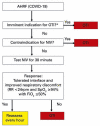
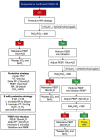

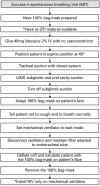

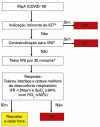


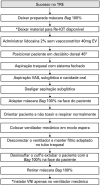

Comment in
-
Comment to: Intensive support recommendations for critically-ill patients with suspected or confirmed COVID-19 infection.Einstein (Sao Paulo). 2020;18:eCE5931. doi: 10.31744/einstein_journal/2020ce5931. Epub 2020 Aug 5. Einstein (Sao Paulo). 2020. PMID: 32785567 Free PMC article. No abstract available.
References
-
- .Huang C, Wang Y, Li X, Ren L, Zhao J, Hu Y, et al. Clinical features of patients infected with 2019 novel coronavirus in Wuhan, China. Lancet. 2020;395(10223):497-506. Erratum in: Lancet. 2020 Jan 30. - PMC - PubMed
- Huang C, Wang Y, Li X, Ren L, Zhao J, Hu Y, et al. Clinical features of patients infected with 2019 novel coronavirus in Wuhan, China. Lancet . 2020;395(10223):497–506. Erratum in: Lancet. 2020 Jan 30. - PMC - PubMed
-
- .Guan WJ, Ni ZY, Hu Y, Liang WH, Ou CQ, He JX, Liu L, Shan H, Lei CL, Hui DSC, Du B, Li LJ, Zeng G, Yuen KY, Chen RC, Tang CL, Wang T, Chen PY, Xiang J, Li SY, Wang JL, Liang ZJ, Peng YX, Wei L, Liu Y, Hu YH, Peng P, Wang JM, Liu JY, Chen Z, Li G, Zheng ZJ, Qiu SQ, Luo J, Ye CJ, Zhu SY, Zhong NS; China Medical Treatment Expert Group for Covid-19. Clinical Characteristics of Coronavirus Disease 2019 in China. N Engl J Med. 2020;382(18):1708-1720. - PMC - PubMed
- Guan WJ, Ni ZY, Hu Y, Liang WH, Ou CQ, He JX, Liu L, Shan H, Lei CL, Hui DSC, Du B, Li LJ, Zeng G, Yuen KY, Chen RC, Tang CL, Wang T, Chen PY, Xiang J, Li SY, Wang JL, Liang ZJ, Peng YX, Wei L, Liu Y, Hu YH, Peng P, Wang JM, Liu JY, Chen Z, Li G, Zheng ZJ, Qiu SQ, Luo J, Ye CJ, Zhu SY, Zhong NS, China Medical Treatment Expert Group for Covid-19 Clinical Characteristics of Coronavirus Disease 2019 in China. N Engl J Med . 2020;382(18):1708–1720. - PMC - PubMed
-
- .World Health Organization (WHO). Coronavirus disease 2019 (COVID-19) Situation Report – 88. Data as received by WHO from national authorities by 10:00 CEST, 17 April 2020 [Internet]. Genebra: WHO; 2020 [cited 2020 Apr 28]. Available from: https://www.who.int/docs/default-source/coronaviruse/situation-reports/2...
- World Health Organization (WHO) Coronavirus disease 2019 (COVID-19) Situation Report – 88. Data as received by WHO from national authorities by 10:00 CEST, 17 April 2020 . Genebra: WHO; 2020. [cited 2020 Apr 28]. Internet. https://www.who.int/docs/default-source/coronaviruse/situation-reports/2....
-
- .Zhu N, Zhang D, Wang W, Li X, Yang B, Song J, Zhao X, Huang B, Shi W, Lu R, Niu P, Zhan F, Ma X, Wang D, Xu W, Wu G, Gao GF, Tan W; China Novel Coronavirus Investigating and Research Team. A Novel Coronavirus from Patients with Pneumonia in China, 2019. N Engl J Med. 2020;382(8):727-33. - PMC - PubMed
- Zhu N, Zhang D, Wang W, Li X, Yang B, Song J, Zhao X, Huang B, Shi W, Lu R, Niu P, Zhan F, Ma X, Wang D, Xu W, Wu G, Gao GF, Tan W, China Novel Coronavirus Investigating and Research Team A Novel Coronavirus from Patients with Pneumonia in China, 2019. N Engl J Med . 2020;382(8):727–733. - PMC - PubMed
-
- .World Health Organization (WHO). Clinical management of severe acute respiratory infection when COVID-19 is suspected. Interim guidance [Internet]. Genebra: WHO; 2020 [cited 2020 Apr 28]. Available from: https://www.who.int/publications-detail/clinical-management-of-severe-ac...
- World Health Organization (WHO) Interim guidance . Genebra: WHO; 2020. [cited 2020 Apr 28]. Clinical management of severe acute respiratory infection when COVID-19 is suspected. Internet. https://www.who.int/publications-detail/clinical-management-of-severe-ac....
MeSH terms
LinkOut - more resources
Full Text Sources
Miscellaneous

